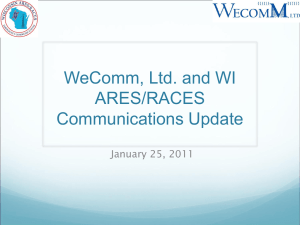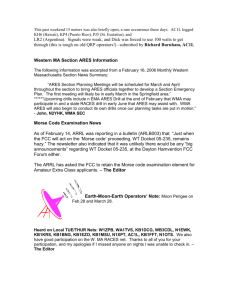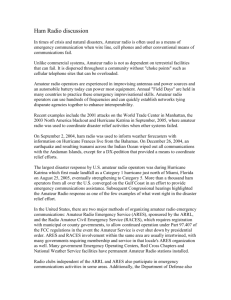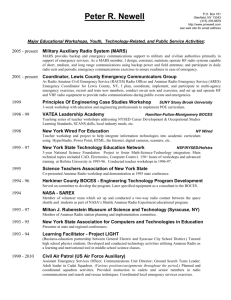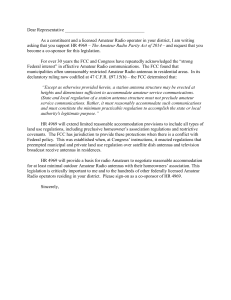Amateur Radio Emergency Communications
advertisement
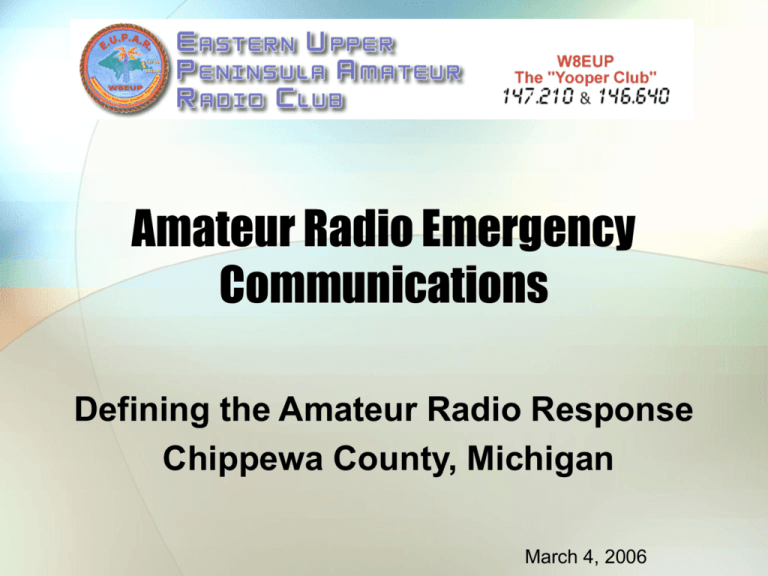
Amateur Radio Emergency Communications Defining the Amateur Radio Response Chippewa County, Michigan March 4, 2006 Chippewa County ARES/RACES Marv DeWitt, KC8MLD Emergency Coordinator (right) with Ron Peterka, WA8OOH, AEC/ARO Digital Director Tim McKee Office of Emergency Services (center) 2 Chippewa County ARES/RACES Prepared by: Lyle Willette, AB8CB Public Information Officer (retired) 3 PURPOSE: • Review “Old” ARES and RACES programs • Introduce post 9/11 and Katrina issues • Explore training and certification requirements • Plan for changes in ARES/RACES 4 “Old” ARES Program • Amateur Radio Emergency Service • Administered by ARRL • Required only amateur radio license and registration • Good county and section administration and organization • Poor organization at the national level • Primarily composed of local 2-meter nets; a few HF, QMN and NTS liaison stations 5 “Old” RACES Program • Radio Amateur Civil Emergency Service • Developed during WWII • Allowed EOC stations to continue to operate during national security or communications emergencies • Directed by federal government • Administered by state and local emergency management agencies • No standardization of training, skills or equipment 6 Post 9/11 Issues 7 Post 9/11 Issues • City EOC located at 7 World Trade Center • Lack of communications interoperability for first responders • Multiple sites/incidents (NYC, Washington D.C., Pennsylvania) • Local and state nets activated • No national coordination of amateur radio resources 8 Post 9/11 Issues • Wide variation in served agency perceptions and use of amateur radio resources • Faced possible termination of all amateur radio operations for national security reasons; fortunately, no one thought of it • No national emergency response plan for amateur radio • Old ARES and RACES structure precluded efficient use of amateur radio resources 9 Post Katrina… 10 …and Rita Issues 11 Post Katrina and Rita Issues • Department of Homeland Security established by now • FEMA downsized as “duplicate functions” assumed by other DHS agencies • Timely and accurate warnings • First test of National Incident Management system • Failure to recognize the potential devastation and loss of life 12 Post Katrina and Rita Issues • Massive loss of virtually all infrastructure • Few HF stations left in operation • VHF, UHF networks destroyed • VoIP links maintained via satellite • Many trained and properly equipped operators turned away, even in areas with light or moderate damage • No deployment plan or pre-staging of amateur radio resources 13 Post Katrina and Rita Issues • Still no national amateur radio emergency response plan • Poor use of basic Incident Management System concepts: • Staging Areas • Management of Resources • Damage Assessment • Attempted use of amateur radio resource database (after the fact) • ARES/RACES structures do not reflect DHS mandated training 14 Post Katrina and Rita Issues • Other organizations worked tirelessly to assist emergency responders that, due to the storm, did not have the equipment and means to effectively carry out their duties. Amateur Radio Operators from both the Amateur Radio Emergency Service and the American Radio Relay League, monitored distress calls and rerouted emergency requests for assistance throughout the U.S. until messages were received by emergency response personnel. A distress call made from a cell phone on a rooftop in New Orleans to Baton Rouge was relayed, via ham radio, from Louisiana to Oregon, then Utah, and finally back to emergency personnel in Louisiana, who rescued the 15 stranded victims.11 Ham radio operators voluntarily manned the amateur radio stations at sites such as the National Hurricane Center, Hurricane Watch Net, Waterway Net, Skywarn and the Salvation Army Team Emergency Radio Network.12 • - from “The Federal Response to Hurricane Katrina”, The White House 15 A Quick Analysis • Both ARES and RACES are outdated • “Required” training and equipment are determined at the local level • Some counties have no program at all (“We don’t need any amateurs in an emergency!”) • Some counties have outstanding resources, but are unwilling to share • Some reluctance still exists to integrate NTS with EmComm • No procedures exist for deployment 16 Training and Certification From the ARRL Letter: “The Board also resolved to establish an ad hoc ARRL National Emergency Response Planning Committee "to appropriately prepare for future largescale disasters." The panel will develop a comprehensive recommendation for ARRL responses to national, regional and international disasters. The Board will consider the recommendations at its 2007 annual meeting next January.” Our issues are being addressed! 17 Training and Certification • ARRL Certification and Continuing Education courses: • Level 1, 2 and 3 • Digital Communications • VHF/UHF Beyond the Repeater • IS-100, 200, 700, 800 • ARES Handbook • Public Service Communications Manual • Section and local products 18 Training and Certification • National Incident Management System resource typing • How do we identify an “Amateur Radio Type 1 Unit”? • How do we ensure that each unit reflects common training, equipment, duty cycle and interoperability? • Much e-mail banter on the subject, many are concerned. • We must attempt to conform to nationally accepted standards once they are approved. 19 Training and Certification • Credentials • Must be earned through training, testing and demonstrated ability • Must be accepted by local, state and federal authorities • Must allow access to appropriate sites and disaster areas, based upon need and approval of a central controlling authority (DHS?) • Should optionally show resource typing • Should be used with written orders to report, signed by requesting authority 20 Possible Changes in ARES/RACES • Dissolution of ARES and RACES in favor of a new national organization • Restructuring of ARES, pending recommendations of National Board • Reassignment of RACES to another DHS, FCC or government body • Increased training in RACES to bring program on a par with MARS • And possibly no changes at all on a national level 21 Michigan Lyle and Marv, we in Michigan are in fact working towards this type of thing as we speak. Marv, as soon as we have the particulars worked out we will be rolling it out to the rest of the state. We only have until October 1, 2006 to become compliant in IS-700 at this time. So the timeline is very short. This was just brought to our attention by MSP-EMD in a January 17, 2006 dated memo. Marty Mendelson, N8MG Changes in ARES in Michigan are definitely coming down the pike. We can assume a requirement for at least IS-700. 22 Chippewa County • We should continue as a combined ARES/RACES organization • We should accept the training requirements that may be imposed • We should “get ahead of the power curve” by seeking training above that which is merely required • We should closely coordinate and cooperate with Mr. McKee • We should advocate a state and federal plan for amateur radio 23 Chippewa County • Define a mission • Local • Regional • National 24 Chippewa County R.A.C.E.S. Mission: T he mission of Chippewa County Radio Amateur Civil Emergency Service is to establish and maintain the leadership, organization and infrastructure necessary to provide emergency radio communications in support of emergency management entities throughout Chippewa County, Michigan: When conventional communications are inadequate to meet public safety or humanitarian needs; When amateur radio resources may help facilitate response or recovery in any emergency situation; When lives and property can be protected; When human suffering can be relieved; Whenever and wherever it becomes necessary, so no community in need is without essential communication service. Guiding Principles: Chippewa County RACES strives to enhance the reliability, quality and professionalism of Radio Amateur Civil Emergency Service personnel through the establishment of stringent training and performance standards, policies, procedures, management of, and supervision of amateur radio operators registered with the organization that may be activated to provide communications on behalf of the served agencies and clients requesting our voluntary assistance. 25 Vision: Chippewa County RACES pledges a commitment to preparedness and service in protection of public health, safety and welfare by encouraging innovative leadership and individual responsibility which enhances the reliability and excellence of amateur radio emergency communications. We motivate amateur radio operators to excel in all facets of emergency communications and recognize those who exemplify our RACES philosophy. Values: Chippewa County RACES members reflect the following qualities and personal values: We are responsible and accountable, We demonstrate integrity and initiative, We are truthful and respectful in relations with other members and those we serve, We are, above all, trustworthy, We strive to become well-integrated members of an action team, We strive to maintain personal growth throughout all activities, and We are competent to perform our assigned duties and responsibilities. 26 Chippewa County • What is wrong with the Mission Statement? • It does not reflect a willingness to respond to regional or national emergencies! • It does not provide for incoming or outgoing mutual aid exchanges! 27 Brainstorming Scenarios and Responses • In the next couple of minutes, jot down some events that may trigger an amateur radio emergency activation. • Also write down some ideas on how we could or should respond to these events. 28 29 Brainstorming Scenarios and Responses • Shout out your scenarios, and I will write them on the whiteboard, and we will discuss responses after each one. • Afterwards, we will look at a few that I came up with… 30 Brainstorming Scenarios and Responses • • • • • • • Weather (summer/winter) Internet down Telephone down 911 communications down Electric utility down Natural gas and propane HAZMAT 31 Brainstorming Scenarios and Responses • • • • • • • Terror Alert Level Orange or Red Actual terrorist activity Transportation Border Shutdown Search and rescue Major aircraft accident Others? 32 Requirements What is required for us to respond? Personal training, knowledge and ability Equipment- Radios, power, antennas, vehicles, clothing, etc. Deployment- Procedures, equipment, reporting authority, credentials 33 Technologies • UHF- ATV, voice, digital, linked repeaters • VHF- Voice, digital, repeaters • HF- CW, phone, PSK-31, digital • APRS – Tracking, damage assessment, messaging • Winlink – e-mail • ATV and digital photos • VOIP 34 Incorporating Ideas into a Plan • Different emergencies may require different skills, training and equipment; however, can we identify common denominators? • Operators may be needed at the EOC, at home and/or in the field. How can we best utilize the few operators that we have? 35 Incorporating Ideas into a Plan • What modes and methods are the easiest and most efficient? • Can we support multiple, simultaneous incidents? • Should we explore resource typing through trial and error, or wait until a model is accepted? 36 Documents • Mission Statement • Annex to County Emergency Operations Plan, after state model • Training Checklist Mandated training Demonstration of abilities Certification • Personal equipment checklist • Organization owned equipment • Accepted national credentials 37 Documents • Annex to State EOP, after national model • Standard Operating Procedures • Frequencies, modes, methods, backups • How-to-do-it information subject to frequent changes • Alerting lists, membership roster • Mutual aid policy to assist other counties and sections 38 Summary • There is much work to be done…and few hands to do it. • When and if state and county models are developed, how well will we be able to adapt the plan to our needs? • Can we retain the members we have and add to our equipment? 39 Summary • Can we grow, as a professional organization, to more fully support Chippewa County? • Can we assist other counties in the state on a mutual aid basis? • Can we assemble a team capable of traveling long distances and operating unsupported? 40 Summary • ARES and RACES will probably change • Our mission should be expanded to provide mutual aid • Our documents and plans may need frequent changes to reflect imposed mandates and policies • We need to examine “the most bang for the buck” strategies in methods, modes and equipment 41 Summary • We must accept additional training requirements and eagerly pursue such training • We must commit ourselves to becoming “Amateur Radio First Responders”, with all the professionalism that it requires • We must recruit new members…but people enjoy belonging to elite volunteer groups 42 Summary It is time for us to talk the talk, walk the walk and sing the song. It is not your father’s ARES and RACES anymore. This is a new ballgame in a new age. We have the support of many agencies and groups. Most importantly, we have the support of our own Emergency Management Director, Mr. Tim McKee 43 Summary The road ahead may not be very clear, but we are certainly going forward and our vision is improving. By working as a team and using all of our abilities and resources, we CAN handle the job before us, for our families, our neighbors and our country. 44 The End, part 1 I hope that this exercise has given you a new awareness of our changing mission, and how we plan on getting it done. Your own ideas, thoughts and concerns are very important to the entire team. Do I have to tell Amateur Radio Operators that we HAVE to communicate? Stick with us, and I think you will see some great things come along… 45 The End, part 2 Thank You and 73! We can’t do it without YOU! Lyle, AB8CB Marv, KC8MLD Director Tim McKee 46
